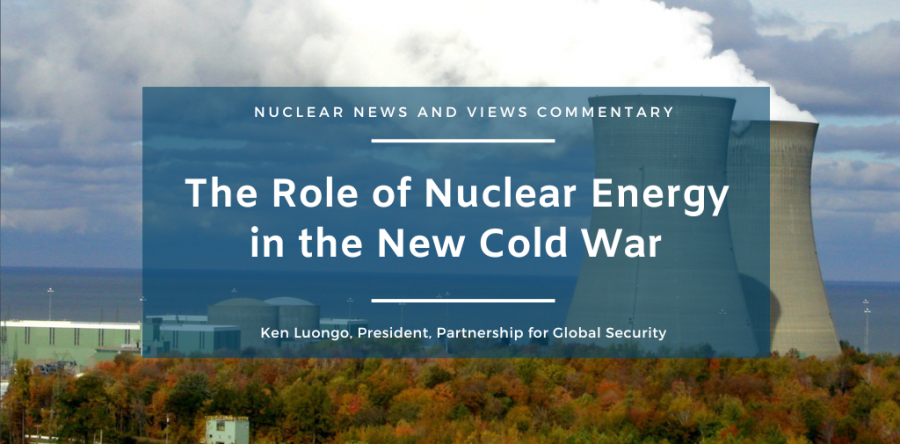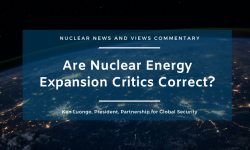A longer version of this article was published by the Center for the National Interest and it can be found here.
The United States is at the front end of a new Cold War, but this time the critical role of atom splitting has been transmuted. Rather than relying on nuclear fission to deliver security in the form of a nuclear bomb, its value now lies in the ability to supercharge cutting-edge technological advancements, such as artificial intelligence (AI).
To be successful, the U.S. government, its allies, and the private sector will need to disentangle the multiple opportunities, geopolitical imperatives, and differing technologies and timelines. They need to create an interconnected, strategic approach to nuclear reactor and fuel deployment that achieves near-term progress while protecting the markets of the future.
Three Spheres of Nuclear Expansion
There is no shortage of federal financing, Executive Orders, or political support for nuclear power in America. But, despite this spigot of cash and commands, it is difficult to see how this frenzy of nuclear activity results in real achievements on a predictable timeline.
There are three intersecting spheres of nuclear expansion that should form the foundation of a needed roadmap, each one having unique geopolitical imperatives, technology composition, and timelines.
Expanding Nuclear Energy in Eastern Europe
The geopolitical foundation to expand nuclear power in Eastern Europe is to decouple from Russian energy dependence. The war in Ukraine has been a game-changer for Europe.
Eastern Europe is well-suited for large gigawatt (GW) sized reactors and several Eastern European nations already operate Russian reactors. But virtually all of them are now seeking American or South Korean fuel conversions and reactors.
Poland has contracted with Westinghouse to build three AP-1000 reactors, while the Czech Republic has chosen to build two Korean APR-1400. Similarly sized reactors are being pursued by Bulgaria, Romania, Slovakia, and Slovenia. There is interest in small modular reactors (SMRs), but these are likely a later prospect.
The primary American strategic objective in Eastern Europe is to lock down the expansion of the large reactor market and keep Russia and China out. But it must work with allies to deliver the reactors on time and on budget while building a stronger supply chain. And it needs to ensure that a future SMR wave is controlled by the United States and its allies.
Advancing Nuclear Energy in America
America has decided that winning the AI race with China is an absolute geopolitical imperative, and the Trump administration aims to provide the substantial power needed to win.
There are two streams of nuclear technology that are moving forward to meet this need.
1. Small modular and advanced technology reactors
Most attention has been focused on small modular and advanced technology reactors. They have unique design features when compared to traditional, large reactors, and have attracted substantial financial support from major AI technology companies.
A major challenge for small and advanced reactor companies is their timeline for deployment. In the U.S., only NuScale Power has regulatory approval for its reactor. Many others are likely a decade away from deployment. There are also serious concerns about whether the exotic fuels required for these novel reactor designs can be delivered on time. Then there is the reliability of output. The historical record indicates that advanced-type reactors operated in the United States, Germany, France, and Japan have all faced serious operational challenges.
2. Large nuclear reactors
The alternative to SMRs as the AI backbone is the traditional large reactor like the Westinghouse AP-1000. It has a distinct advantage over SMRs because the reactor has been licensed by the NRC and has been built in the U.S. and overseas.
The Trump administration has committed $80 billion to the construction of 10 GW of AP-1000 power in the United States. And at least one administration energy official has indicated that the U.S. government could buy and own “as many as 10 new, large nuclear reactors” using Japan’s commitment to invest $550 billion in the U.S.
The challenge for the AP-1000 is that utilities and investors are hesitant to commit to new construction and the cost risks. In response, the Trump administration is advancing a dual-track strategy by identifying federal land for reactor construction.
A number of small reactor developers are already using the national laboratories as homes for their reactor developments. One example of the potential combination of federal land and the AP-1000 is Fermi America’s Project Matador. It plans 10 AP-1000s for deployment in Amarillo, Texas adjacent to the Pantex plant.
The domestic objective for the U.S. is to underscore the national security importance of a nuclear power build-out and secure a concrete commitment to construct a set of new large and small reactors. That will require a purchaser for the power, and if AI flags, and the utilities have cold feet, the alternative buyer may be the U.S. government.
Capturing Emerging Markets in the Global South
The geopolitical imperative to capture emerging nuclear markets is strong. It blocks authoritarian competitors like Russia and China from key markets, it creates a 100-year-long energy partner, and it provides the power these nations need as their populations and economies grow. But these are the places where the least amount of strategic and creative thinking has been done.
The U.S. and Saudi Arabia seem to be moving towards a large reactor deal. But many of these nations are not well-suited or financially prepared for a large GW-sized nuclear reactor. They could better use SMRs. So, nurturing those markets for small reactors in advance of their deployment is an important opportunity.
Russia and China have a significant advantage in cultivating these nations. Russia has signed over 15 nuclear power agreements with African nations since 2017, while the United States has signed two. China is capturing energy infrastructure through the Belt and Road Initiative (BRI), which now has 149 countries in its orbit. Russia and China are already operating SMRs.
The objective for the emerging economy nations is to capture these markets for American and allied SMRs and prepare these nations for nuclear operation in an expedited manner. America hasn’t done a great job on this and continues to rely on the slow, incremental process of capacity building that rarely reaches a conclusion. Its export financing is weaker than the opportunities.
Therefore, the U.S. and its allies need to consider some creative options, including Energy Security Compacts, reactor-exporter Build-Operate-Transfer models, and an expansion of the resources and remit of the Development Finance Corporation and the Export-Import Bank. There also is the potential to combine Middle Eastern and OECD nation sovereign wealth and export agency financing to create a super-pool of resources that can support broad nuclear deployment in emerging economies. This can solidify a new, responsible nuclear energy security coalition with rippling geopolitical benefits in the new Cold War.
Ken Luongo, President, Partnership for Global Security





